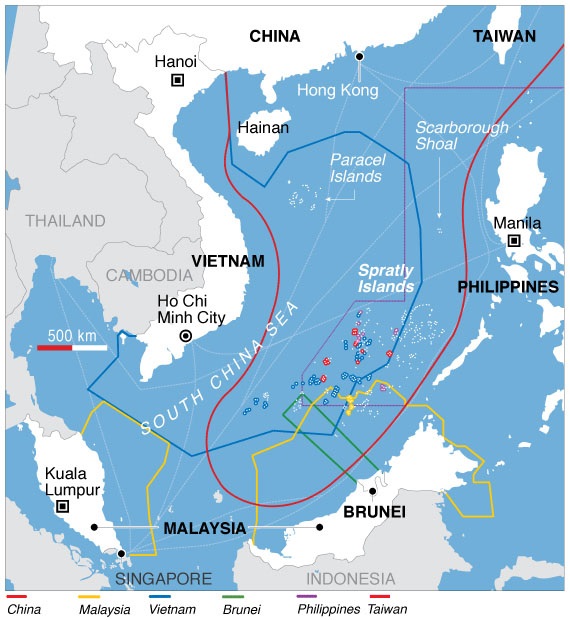
These has been a little rumbling lately in the news about Malaysia and Vietnam asserting their territorial rights in the South China Sea. Of course, part of the area they asserting is part of their 200 mile economic exclusion zone happens to be territory that Red China also claims. These are not the only countries that have such conflicts. Bordering the South China Sea is China, Taiwan, Philippines, Indonesia, Brunei, Singapore, Malaysia, Thailand, Cambodia and Vietnam. There countries with competing claims are China, Taiwan, Philippines, Indonesia, Brunei, Malaysia and Vietnam. Let us look at their naval assets for a moment.
China has the largest navy in the region. Their fleet (the People’s Liberation Army Navy) consists of:
2 new carriers – 54,500 to 58.600 tons (one commissioned in 2019)
36 Destroyers – 3,670 to 12,000 tons
52 Frigates – 2,000 to 4,200 tons
42 Corvettes – 1,400 tons
109 Missile boats – 170 to 520 tons
94 Submarine chasers
17 gunboats
20 mine countermeasures vessels – 400 to 1,200 tons
6 Amphibious transport docks (LPD) – 25,000 tons
1 Mobile Landing Platform
32 Landing Ship Tanks (LST) – 4,170 to 4,800 tons
31 Landing Ship medium (LSM) – 800 to 2,000 tons
7 Ballistic Missile Submarines (SSBN) – 8,000 to 11,500 tons
12 Nuclear attack Submarines (SSN) – 5,500 to 7,000 tons
55 Attack submarines (SSK) – 2,110 to 4,000 tons
The fleet also includes a 12 replenishment oilers and 232 various auxiliaries. The fleet is definitely growing and will have a third carrier around 2022.
The other countries have:
…………………….Taiwan……Philippines…..Indonesia….Brunei….Malaysia….Vietnam
Destroyers………..4
Frigates…………..22…………..(2)……………..8…………………………..6……………..9
Corvettes………….1…………….1…………….10…………………………..6……………14
Subs (SSK)………4……………..0……………..5……………………………2……………..6
ASW Corvettes…………………………………14
Patrol Vessel……………………11………………………………4…………..8
Patrol ships……….12…………..7……………37……………..9…………..8
Missile boats……..31………………………….15……………………………8
Mine sweepers….10………………………….12…………………………….4……………..8
Patrol boats……………………58…………..104……………23………….17……………54?
LSD…………………..1………….2……………..5
LST…………………..2………….5…………….12
LSM………………………………………………12…………………………………………..6?
Auxiliaries…………..5……….13………………42…………………………..14…………..12
The Taiwanese corvette is 567 tons, their patrol ships are 580 tons, their missile boats are 171 tonnes. The small Philippine fleet will get two frigates (2,600 tons) in 2020. Their corvette is 1,200 tons. Their offshore patrol vessels range from 712 to 3,250 tons. The patrol ships range from 140 to 357 tons, their patrol and missile boats are all less than 60 tons. The Indonesian ASW Corvettes 950 tons, East German built (we have a piano from East Germany).
There are some other countries on the periphery of this conflict, like Singapore, Thailand and Cambodia. We will address them in a subsequent post.

Interesting to see that in two years the Chinese destroyer fleet grew by 40% and corvettes by 67%. The carrier fleet is 50% larger with the launch of a third vessel, larger and more capable than its predecessors.
The size of the submarine fleet, on the other hand, has remained static, though I’m guessing it will grow at a similarly rapid pace in the years ahead once the Chinese finalize more modern designs.